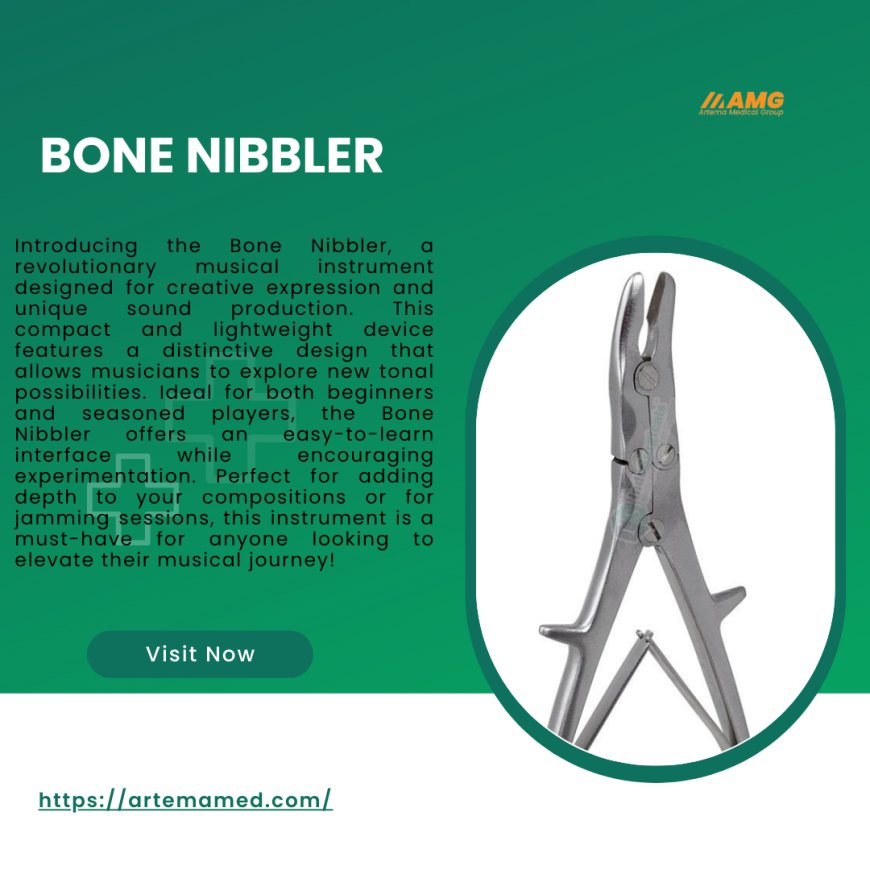The Importance of Bone Nibble in ENT Surgeries
the bone nibble, a tool designed to remove small sections of bone with precision and control.

In the field of surgery, precision is paramount, especially when operating on delicate areas like the ear, nose, and throat (ENT). One critical instrument used in these procedures is the bone nibble, a tool designed to remove small sections of bone with precision and control. The ENT bone nibble plays an essential role in various surgeries, where even minor errors can have significant consequences. Its importance lies in its ability to remove bone with minimal disruption to surrounding tissues, making it indispensable in ENT and other specialized surgical fields.
What is a Bone Nibble?
A bone nibble, also referred to as a bone nibbler, is a specialized surgical instrument with sharp-edged jaws that "nibble" away at small portions of bone. The instrument allows for controlled removal of bone, making it especially useful in surgeries requiring high levels of accuracy, such as those in the confined spaces of the ear, nose, and throat. The tool's design varies based on the specific needs of the surgery, with different sizes, angles, and action mechanisms available.
Importance of the ENT Bone Nibble in Surgical Procedures
In ENT surgeries, the ENT bone nibble is a critical instrument for several reasons:
1. Precision in Confined Spaces
ENT surgeries often require work in very small and complex areas, such as the inner ear or nasal cavities. The ENT bone nibble allows surgeons to remove small portions of bone with high precision, which is vital when working near sensitive structures like nerves, blood vessels, or other critical tissues. This precision ensures that bone removal is minimal, reducing the risk of damage to surrounding areas and improving patient outcomes.
2. Controlled Bone Removal
Unlike other instruments that may take larger cuts, the bone nibble allows for incremental removal of bone. This is particularly important in procedures like mastoidectomy, where only the infected or damaged portion of the mastoid bone needs to be excised. The ENT bone nibble provides the surgeon with control over the amount and location of bone removal, making it an ideal tool for procedures where precision is paramount.
3. Versatility in ENT Procedures
The ENT bone nibble is versatile and can be used in a variety of surgeries. For example, in sinus surgery, it may be used to remove bone obstructing the sinuses, improving airflow and drainage. In septoplasty, the nibble allows for the precise reshaping or removal of bone and cartilage to correct a deviated septum. The versatility of this instrument across different procedures makes it an essential tool for ENT surgeons.
4. Minimally Invasive Surgery
As medical technology advances, there is a growing trend towards minimally invasive surgical techniques. The bone nibble plays a significant role in this shift, as it allows for bone removal through smaller incisions. The use of this instrument helps minimize tissue damage, reduces recovery times, and leads to better cosmetic outcomes for patients. This is particularly beneficial in facial surgeries, where the reduction of visible scarring is a priority.
Key Features that Make the Bone Nibble Essential
The ENT bone nibble is designed with specific features that make it indispensable for surgeons:
1. Ergonomic Design for Comfort
ENT surgeries can be lengthy and require precise, steady hands. The bone nibble is often ergonomically designed to reduce surgeon fatigue, allowing for better control throughout the procedure. The comfortable handling ensures that surgeons can maintain precision during delicate operations.
2. Double-Action vs. Single-Action
Bone nibblers come in both single-action and double-action varieties. A double-action bone nibble provides smoother cutting with less effort, ideal for more extensive surgeries where the surgeon may need to remove larger portions of bone. This feature helps reduce the physical strain on the surgeon, which can improve overall accuracy and control during the procedure.
3. Durable Materials for Surgical Demands
Bone nibblers are typically made from high-quality stainless steel or other medical-grade materials that withstand frequent use and sterilization. This durability ensures that the ENT bone nibble remains sharp and effective, even after repeated surgeries. The strength of these materials allows for efficient bone removal, while the design helps maintain sterility during use.
Procedures That Rely on the ENT Bone Nibble
Several ENT procedures benefit from the use of the bone nibble, including:
-
Mastoidectomy: Used to remove infected air cells within the mastoid bone of the ear, the ENT bone nibble helps excise bone while avoiding damage to surrounding healthy tissues, such as the facial nerve.
-
Septoplasty: In surgeries to correct a deviated septum, the bone nibble allows surgeons to reshape the nasal bone and cartilage without disrupting the structural integrity of the nose.
-
Endoscopic Sinus Surgery: The bone nibble is often used to remove small bone obstructions that block sinus drainage, ensuring better patient outcomes with minimal invasiveness.
The Future of Bone Nibbles in ENT Surgery
As surgical techniques and technology continue to evolve, the bone nibble is likely to see further innovations. Improvements in material science may lead to even more durable, lightweight instruments that increase comfort and precision for surgeons. Additionally, as robotic-assisted surgeries and minimally invasive techniques gain popularity, we may see the integration of bone nibblers into robotic systems, providing surgeons with even greater control and accuracy during procedures.
Conclusion
The ENT bone nibble is an indispensable instrument in the world of ENT surgery. Its precision, control, and versatility make it essential for procedures involving bone removal in the ear, nose, and throat regions. Whether used in a mastoidectomy, septoplasty, or sinus surgery, the bone nibble allows for the accurate removal of bone with minimal disruption to surrounding tissues. As technology continues to advance, the importance of this tool will only grow, helping surgeons achieve better outcomes for their patients while reducing recovery times and improving overall surgical success.
What's Your Reaction?






















![[Latest] medical adhesive tapes Market to Cross $13.62 Billion in Total Revenue by 2030 | Riding on a Strong 5.6% CAGR](https://news.bangboxonline.com/uploads/images/202408/image_430x256_66d155cde3765.jpg)